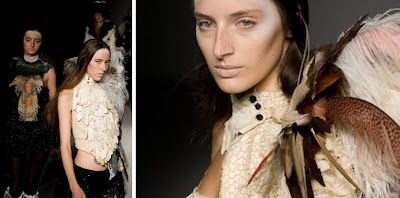London-based Iraqi-British designer Reem Alasadi has managed to blow the fashion world’s collective minds since launching her label two decades ago. Her hand-crafted clothing has appeared in the pages of Vogue, Harpers Bazaar and Dazed & Confused, while luring Madonna amongst her many fans. The Polyglot caught up with the Iraqi-born designer to discuss the realities of working in today’s fashion world.
 How did you get your start in fashion?
How did you get your start in fashion?
My fascination with fashion began as a teenager in Maidstone, Kent, where I lived with my family after emigrating from Iraq at the age of eight. At 16, I was accepted at both Central St. Martins and the London College of Fashion. I had a year to go before school started so I apprenticed with Karen Millen, who at that time was working out of a small store in Maidstone. When it came time to go to college, I realized I didn’t want to be a student. So I taught myself patternmaking and construction, by taking apart vintage clothing and refashioning them into new garments.
 Who were your first clients?
Who were your first clients?
I really began at a grass-roots level, by setting up a stall at the Portobello Market to sell my customized vintage pieces. Portobello is where most designers and stylists come for inspiration and eventually they started to take a keen interest in my work. One day the designer John Richmond asked me to style his show in Milan. It was an offer I couldn’t refuse! This opened the door to other opportunities as a trend forecaster and brand consultant for the likes of Stella McCartney and Robert Carey-Williams. But despite having traveled all over the world, I still maintain my stall at the Portobello Market, which is where my career took off.
How challenging is it to set up an independent fashion label?
It was definitely a challenge, and you learn “what not to do” with time and experience. I was 21 when I set up my label from a 1,000 sqft studio in Maidstone. At 22, I already had a “mini-boutique” at the multi-brand Hyper Hyper store on Kensington High Street in London. It is easy for success to get to ones head, but I also realized how naive I was when it came to setting up a business plan and budgets. I had no concept of “seasons;” if it was cold outside; I would make a coat and sell it the next day. Eventually I had to close my business and start over, but those early experiences helped me grow as a designer and lead to the success I’ve experienced today.
 Why do you think your work has such a large following in Japan?Japan has always meant a lot to me because I received a lot of support there early in my career. I first visited Tokyo in 2001, when the Laforet department store in Harajuku created a pop-up boutique to sell my clothes. The next year I became the first non-Japanese designer invited to show during Tokyo Fashion Week. I find that in Japan people tend to appreciate new ideas in fashion, even if they are extreme. You’re more likely to see people on the streets of Tokyo wearing the kind of clothes that would typically only be featured in fashion magazines.
Why do you think your work has such a large following in Japan?Japan has always meant a lot to me because I received a lot of support there early in my career. I first visited Tokyo in 2001, when the Laforet department store in Harajuku created a pop-up boutique to sell my clothes. The next year I became the first non-Japanese designer invited to show during Tokyo Fashion Week. I find that in Japan people tend to appreciate new ideas in fashion, even if they are extreme. You’re more likely to see people on the streets of Tokyo wearing the kind of clothes that would typically only be featured in fashion magazines.
What drove you to create an eco-friendly fashion brand?For me it wasn’t about creating an “Eco Friendly” brand, so much as rethinking the way we do business in order to minimize our carbon footprint. Most consumers don’t realize that the fashion industry is one of the world’s largest polluters. In addition to sourcing organic, naturally hand-dyed fabrics, my clothes are produced in factories that meet ethical and fair-trade standards. A lot of my pieces incorporate recycled and vintage fabrics so that nothing goes to waste. The fur, leather and feathers used in my collections are also the product of ethical farming practices that don’t harm endangered species.
Has this approach also influenced the way you show and sell clothes?
Definitely, I have never met a journalist, buyer or designer that hasn’t complained about the relentlessness pace of the Spring/Summer-Autumn/Winter round of shows. It doesn’t make sense to put time into creating beautiful clothes, which only appear on a runway for a few seconds. For that reason, I decided to combine both my spring and fall collections into one intimate presentation, where people could get close enough to view the clothes and appreciate the work that went into them. It’s not only about respecting the earth’s resources but also our own time, energy and creativity. By showing both seasons together, I can spend more time designing and the buyers can budget in advance.
All images courtesy of Reem Alasadi
© THE POLYGLOT (all rights reserved) CHICAGO-PARIS
 How did you get your start in fashion?
How did you get your start in fashion?My fascination with fashion began as a teenager in Maidstone, Kent, where I lived with my family after emigrating from Iraq at the age of eight. At 16, I was accepted at both Central St. Martins and the London College of Fashion. I had a year to go before school started so I apprenticed with Karen Millen, who at that time was working out of a small store in Maidstone. When it came time to go to college, I realized I didn’t want to be a student. So I taught myself patternmaking and construction, by taking apart vintage clothing and refashioning them into new garments.
 Who were your first clients?
Who were your first clients?I really began at a grass-roots level, by setting up a stall at the Portobello Market to sell my customized vintage pieces. Portobello is where most designers and stylists come for inspiration and eventually they started to take a keen interest in my work. One day the designer John Richmond asked me to style his show in Milan. It was an offer I couldn’t refuse! This opened the door to other opportunities as a trend forecaster and brand consultant for the likes of Stella McCartney and Robert Carey-Williams. But despite having traveled all over the world, I still maintain my stall at the Portobello Market, which is where my career took off.
How challenging is it to set up an independent fashion label?
It was definitely a challenge, and you learn “what not to do” with time and experience. I was 21 when I set up my label from a 1,000 sqft studio in Maidstone. At 22, I already had a “mini-boutique” at the multi-brand Hyper Hyper store on Kensington High Street in London. It is easy for success to get to ones head, but I also realized how naive I was when it came to setting up a business plan and budgets. I had no concept of “seasons;” if it was cold outside; I would make a coat and sell it the next day. Eventually I had to close my business and start over, but those early experiences helped me grow as a designer and lead to the success I’ve experienced today.
 Why do you think your work has such a large following in Japan?Japan has always meant a lot to me because I received a lot of support there early in my career. I first visited Tokyo in 2001, when the Laforet department store in Harajuku created a pop-up boutique to sell my clothes. The next year I became the first non-Japanese designer invited to show during Tokyo Fashion Week. I find that in Japan people tend to appreciate new ideas in fashion, even if they are extreme. You’re more likely to see people on the streets of Tokyo wearing the kind of clothes that would typically only be featured in fashion magazines.
Why do you think your work has such a large following in Japan?Japan has always meant a lot to me because I received a lot of support there early in my career. I first visited Tokyo in 2001, when the Laforet department store in Harajuku created a pop-up boutique to sell my clothes. The next year I became the first non-Japanese designer invited to show during Tokyo Fashion Week. I find that in Japan people tend to appreciate new ideas in fashion, even if they are extreme. You’re more likely to see people on the streets of Tokyo wearing the kind of clothes that would typically only be featured in fashion magazines.What drove you to create an eco-friendly fashion brand?For me it wasn’t about creating an “Eco Friendly” brand, so much as rethinking the way we do business in order to minimize our carbon footprint. Most consumers don’t realize that the fashion industry is one of the world’s largest polluters. In addition to sourcing organic, naturally hand-dyed fabrics, my clothes are produced in factories that meet ethical and fair-trade standards. A lot of my pieces incorporate recycled and vintage fabrics so that nothing goes to waste. The fur, leather and feathers used in my collections are also the product of ethical farming practices that don’t harm endangered species.
Has this approach also influenced the way you show and sell clothes?
Definitely, I have never met a journalist, buyer or designer that hasn’t complained about the relentlessness pace of the Spring/Summer-Autumn/Winter round of shows. It doesn’t make sense to put time into creating beautiful clothes, which only appear on a runway for a few seconds. For that reason, I decided to combine both my spring and fall collections into one intimate presentation, where people could get close enough to view the clothes and appreciate the work that went into them. It’s not only about respecting the earth’s resources but also our own time, energy and creativity. By showing both seasons together, I can spend more time designing and the buyers can budget in advance.
All images courtesy of Reem Alasadi
© THE POLYGLOT (all rights reserved) CHICAGO-PARIS


No comments:
Post a Comment